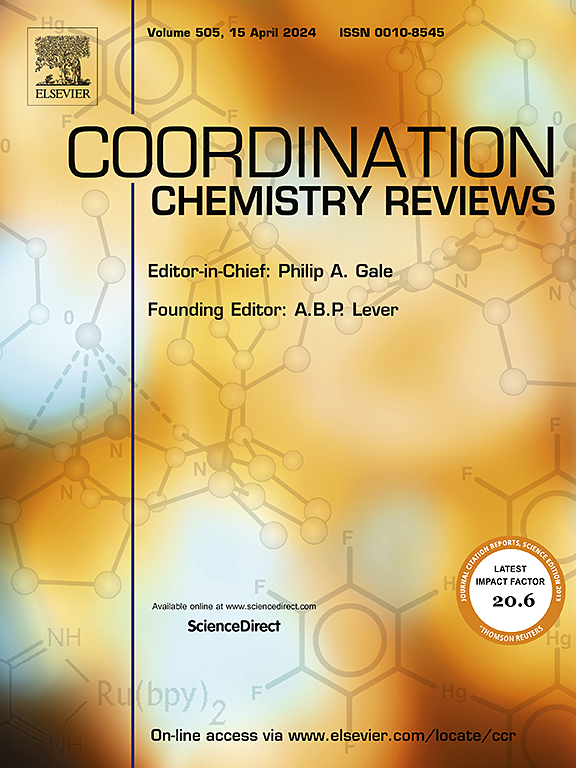用于成像引导光动力治疗的可活化近红外有机光敏剂
IF 23.5
1区 化学
Q1 CHEMISTRY, INORGANIC & NUCLEAR
引用次数: 0
摘要
光动力疗法(PDT)利用光激活光敏剂(PS),产生活性氧(ROS),具有优异的时空选择性和非侵入性。然而,传统的PS一直处于“开”状态,组织穿透性较低,导致在正常细胞中的非特异性积累,对PDT的安全性提出了重大挑战。为了克服这些问题,通过修饰生物分子特异性识别的基团,如低pH和特定酶,开发了近红外(NIR)活化光敏剂(aPS)。这些近红外ap在正常组织中保持“关闭”状态,在近红外激光照射下不能产生ROS。它们被特定的生物标志物激活后,在近红外激光照射下产生荧光和光声信号来显示病变组织,产生ROS来消灭肿瘤和细菌。本文系统地总结了ap的分类、设计策略和响应机制。此外,我们还讨论了ap在生物医学领域的应用前景、面临的挑战和未来的发展方向。本文章由计算机程序翻译,如有差异,请以英文原文为准。

Activatable near-infrared organic photosensitizers for imaging-guided photodynamic therapy
Photodynamic therapy (PDT) utilizes light to activate photosensitizers (PS), generating reactive oxygen species (ROS), and has excellent spatiotemporal selectivity and non-invasive. However, traditional PS is always in the “on” state and has lower tissue penetration, leading to non-specific accumulation in normal cells and presenting significant safety challenges for PDT. To overcome these problems, the near-infrared (NIR) activatable photosensitizers (aPS) have been developed by modifying groups specifically recognized by biomolecules, such as low pH and specific enzymes. These NIR aPS remain in the “off” state in normal tissues and cannot produce ROS under NIR laser light. After being activated by specific biomarkers, they generate fluorescence and photoacoustic signals to visualize lesion tissues, produce ROS to eliminate tumors and bacteria under NIR laser irradiation. This article systematically summarizes the categories, design strategies, and response mechanisms of aPS. Additionally, we discuss the application prospects of aPS in biomedical fields, along with the challenges and future directions for development.
求助全文
通过发布文献求助,成功后即可免费获取论文全文。
去求助
来源期刊

Coordination Chemistry Reviews
化学-无机化学与核化学
CiteScore
34.30
自引率
5.30%
发文量
457
审稿时长
54 days
期刊介绍:
Coordination Chemistry Reviews offers rapid publication of review articles on current and significant topics in coordination chemistry, encompassing organometallic, supramolecular, theoretical, and bioinorganic chemistry. It also covers catalysis, materials chemistry, and metal-organic frameworks from a coordination chemistry perspective. Reviews summarize recent developments or discuss specific techniques, welcoming contributions from both established and emerging researchers.
The journal releases special issues on timely subjects, including those featuring contributions from specific regions or conferences. Occasional full-length book articles are also featured. Additionally, special volumes cover annual reviews of main group chemistry, transition metal group chemistry, and organometallic chemistry. These comprehensive reviews are vital resources for those engaged in coordination chemistry, further establishing Coordination Chemistry Reviews as a hub for insightful surveys in inorganic and physical inorganic chemistry.
 求助内容:
求助内容: 应助结果提醒方式:
应助结果提醒方式:


